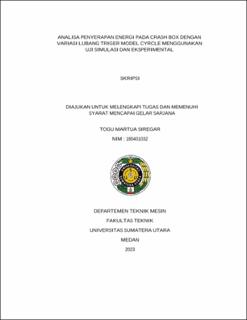Analisa Penyerapan Energi pada Crash Box dengan Variasi Lubang Triger Model Cyrcle Menggunakan Uji Simulasi dan Eksperimental
Analysis of Energy Absorption in Crash Boxes with Variations of The Cyrcle Model Trigger Hole Using Simulation and Experimental Tests

Date
2023Author
Siregar, Togu Martua
Advisor(s)
Nasution, Fadly Ahmad Kurniawan
Metadata
Show full item recordAbstract
With the rapid development in automotive technology, we are required to continue to innovate, create and develop something new, especially the design of motor vehicles (motorcycles, cars, etc.) which requires continuous innovation to create efficient security. Every year, traffic accidents around the world cause more than 1.2 million deaths and tens of millions of injuries. These numbers pose significant problems for public health, trauma care, and traffic safety officers. Solutions have been found to dampen impacts when bumpers are no longer able to dampen them in the event of an accident, one of which is a crash box. This study aims to analyze the energy absorption in the crash box with the variation of the circle model trigger hole through simulation and experimental tests. Simulation tests were carried out to predict the performance of crash boxes with various variations of trigger holes, while experimental tests in the laboratory aimed to validate the simulation results and evaluate the effectiveness of crash boxes in absorbing energy during collisions. The variations in the number of trigger holes tested were 1, 2, and 3 holes. Testing uses a universal testing machine. The simulation results show that the crash box with 1 trigger hole has the largest energy absorption of 117 J, while the experimental results record a maximum energy absorption of 113 J for the same configuration. Along with the increase in the number of trigger holes, energy absorption decreases significantly in both simulation and experimental results. The simulation results for the crash box with 2 and 3 trigger holes showed energy absorption of 106 J and 61 J respectively, while the experimental results showed energy absorption of 108 J and 76 J. The difference in results between the simulation and the experiment was due to several factors, including the assumption of isotropic materials in the simulation and the imperfection of the welding process in the experiment that caused tearing in certain parts. In conclusion, the trigger hole in the crash box tends to reduce the ability of the crash box to absorb energy, and there are several sources of error that need to be corrected in experimental and simulation methods to obtain more accurate results.
Collections
- Undergraduate Theses [981]
